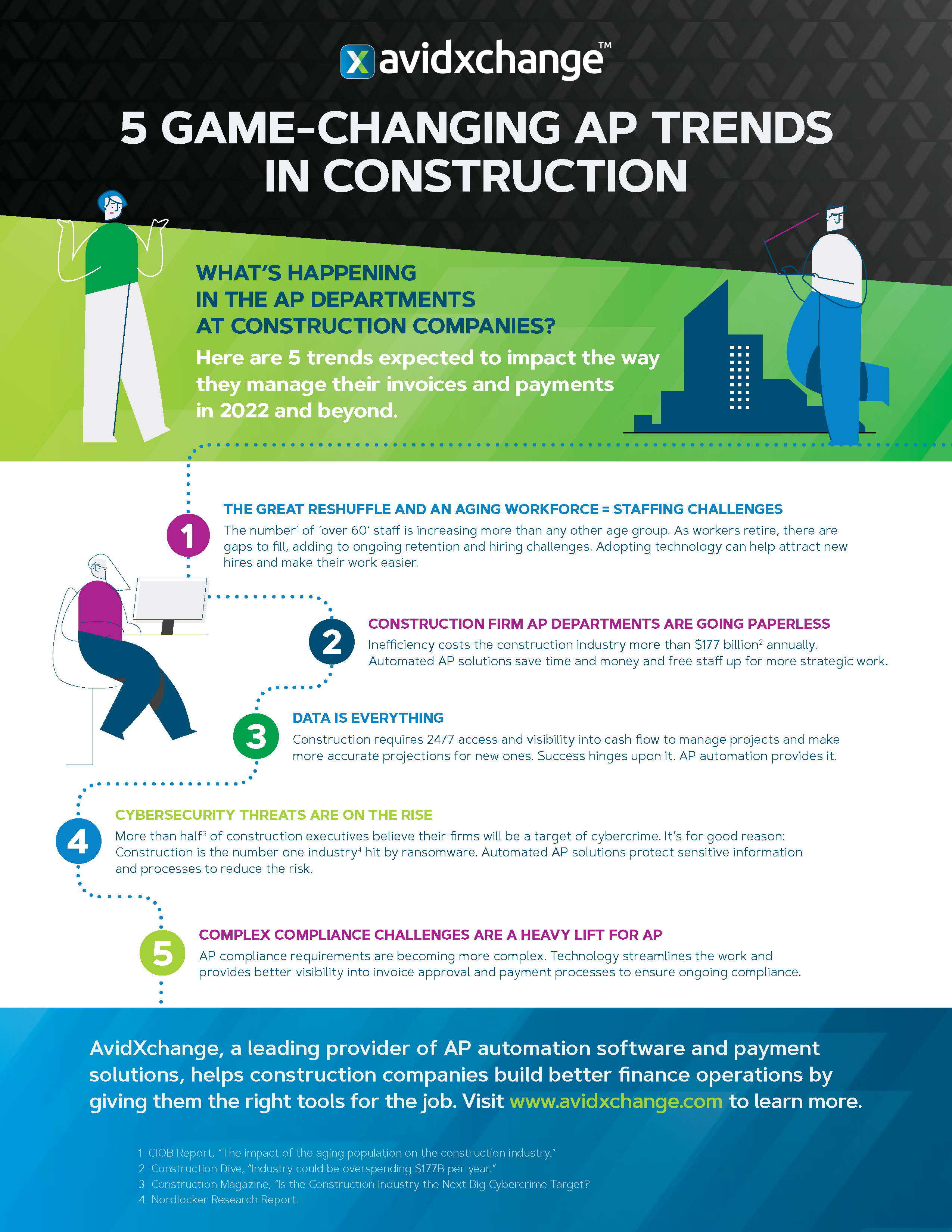Coming off a tumultuous year, the construction industry faces continued pressures, yet the outlook for 2022 is positive. The industry recovered well from the 2020 recession and is more readily embracing technology to enhance productivity and provide a competitive advantage.
We’re taking a look at key construction industry trends predicted to impact the way firms manage their finances, namely invoices and payments — mission-critical processes — and how technology is promising to transform AP departments by creating smarter ways to work.
Here’s a look at the state of AP in construction and five construction industry trends predicted to shape its future in 2022 and beyond:

CLICK HERE TO DOWNLOAD THE INFOGRAPHIC
This handy guide outlines the five trends expected to impact the way construction companies manage their invoices and payments in 2022 and beyond.
1. Continued pressure to adapt to new ways, attract and retain talent
AP teams within the construction industry will continue to deal with a perfect storm when it comes to staffing challenges, including training on new remote processes, replacing an aging workforce, and retaining and attracting talent amidst The Great Reshuffle.
Since the early days of the pandemic when access to offices was restricted, construction firms have been working to train staff to access financial data and manage critical invoice and payment processes remotely. The shift requires the adoption of technology, something the construction industry has been notoriously slow to embrace.
While the move to remote work has been tough on some, especially older workers accustomed to manual ways of working, it’s been a welcome shift for many. Working from home offers greater flexibility and has ignited a flurry of job-hopping for professionals no longer limited by geography and looking for a permanent option to work remotely. Construction firms are realizing that they need to consider offering remote work options in order to hold onto their staff and attract new talent.
Adding to their retention and hiring challenges is an aging workforce.
As this group reaches retirement, it’s leaving gaps to fill and a competitive job market makes it tough to contend with. It’s expected that as the older workforce is replaced by younger generations, they’ll more readily embrace automated AP solutions, which will ease staffing constraints by enabling teams to do more with less.
2. Shifts to entirely paperless AP departments
The construction industry is uniquely poised for entirely paperless AP processes. Teams are scattered across locations, many—including project managers and supervisors who handle invoice approvals— are often away from their offices and continuously moving between job sites, making them hard to reach.
“When construction firms come to us, they are often trying to resolve issues around the management of invoices. It’s not surprising, as they are dealing with incredibly time-consuming, cumbersome manual invoicing processes that involve a lot of waiting and uncertainty. They are looking to create efficiencies so invoices can be approved quickly and can be properly tracked in their financial systems for better visibility and prompt payment.”
Mike Carbino, Product Director, AvidXchange
Many firms have tackled the first piece of automated AP, eliminating time spent opening mail, scanning and keying in details, by automating their invoice processes. They are using optical character recognition technology to enter invoices and send them to approvers’ mobile devices for quick and easy review.
The next step for many is to automate the final stage of the payment workflow—the release of payment. Automated solutions can speed payment delivery and also provide control and transparency over payments. Once approved, payments flow directly into a firm’s accounting system for automated payment processing. They also offer another benefit that’s unique to the construction industry—the ability to manage lien waivers.
There’s a compelling business rationale for moving to an end-to-end automation solution: It creates more efficient processes, saves time and money, eliminates the need for additional headcount, and frees time for more strategic work.
It’s expected that as firms realize the host of benefits and look for competitive advantage, they’ll continue to move toward complete automation solutions.
3. Increased impact of data analysis, margin management
The importance of construction firms’ data is growing as they gain access to more information and more meaningful insights.
Financial metrics and insights are especially valuable to the construction industry as success hinges on managing bids and commitments against budget and time.
“One of the biggest complaints we hear from construction firms is that they never know when they’re going to get invoices back so it’s tough to know where they stand and how well they are managing their vendors,” said Carbino. “Firms need 24/7 access and visibility into what invoices are in—what’s been billed—and when it will be paid. It allows them to better manage their projects and also make more accurate projections for new ones.”
In 2022, firms will rely more and more on this data to evaluate business efficiencies and identify opportunities to save, leaning on technology to help.
According to IOFM, one of the most significant benefits AP automation can provide is the data it generates:
“These metrics can tell a resonating story that’s less biased, more reliable and consistent than manually compiled reports that are dependent upon staff who may collect and assess data differently—and oftentimes sporadically.”
4. Growing cybersecurity threats
Construction firms haven’t escaped the proliferation of cybercrime that has struck organizations around the world, and yet most are woefully unprepared for attacks.
According to a 2021 article in Contractor Magazine citing a survey conducted by IBM, more than half of construction executives believe their firms will be a target of cybercrime, yet 68 percent of firms have no security measures in place.
Equally alarming, construction is the No. 1 industry hit by ransomware, according to new desk research by NordLocker. An analysis of 1,200 companies globally that were hit by cyber extortion between 2020 and 2021 revealed those parts of the market where ransomware is the most widespread. Out of 35 identified industries, the greatest number of ransomware attacks was detected in the construction sector.
Top industries hit by ransomware
Cybercrime tactics run the gamut from phishing campaigns, identity theft and fraud to many other malicious threats aimed at unsuspecting staff. Construction firms are among prime targets, largely because of the vendor data they store.
For instance, when a firm has multiple vendors, they are taking on significant risk by storing the vendors’ payment information on servers that may have questionable security measures in place, if any.
In the new year, firms will be looking to their automated AP solutions to help ward off threats by taking on responsibility. When they adopt an automated payment system, they transfer risk to the automation provider — who has the expertise and strong security measures in place — reducing the risk of criminals accessing sensitive information and also reducing the risk of check fraud.
5. Looming compliance challenges
AP compliance requirements are constantly changing and have become more complex with recent changes to IRS reporting rules, impending 2023 data privacy regulations, and an enhanced emphasis on enforcement of the Corporate Transparency Act and the Anti-Money Laundering Act. Scrutiny over adherence has become more intense as regulators have better access to large quantities of financial data, thanks to electronic record keeping.
Keeping up with compliance requirements is a heavy lift, especially for firms that deal with multiple vendors and do work across state lines. The responsibility and the time-consuming tasks it involves falls on accounting teams.
“All compliance issues at play today have to be managed, consuming more resources than firms can afford. That time can be put to better use, freeing staff for more strategic work.”
Mike Carbino, Product Director, AvidXchange
In 2022, firms are looking at purchasing and AP regulations training to help them avoid compliance issues and the costly penalties and lawsuits that can accompany them. They are also looking at technology to streamline the work, provide better visibility into the invoice approval process, and reduce the need for human interaction which can often lead to error or oversight.



